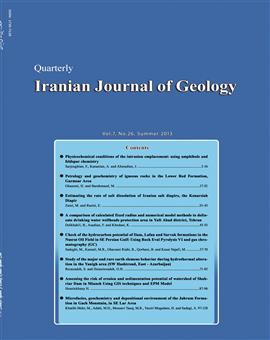Assessing the risk of erosion and sedimentation potential of watershed of Shahriar Dam in Mianeh Using GIS techniques and EPM Model
Subject Areas :
1 - دانشگاه امام حسین(ع)
Keywords: Risk of soil erosion GIS EPM watershed basin Shahriar Dam , Mianeh,
Abstract :
Soil erosion and sedimentation are among the major limitations in applying water and soil resources. Thus, the assessment processes that govern their behavior in order to better understand watershed systems and explain proper management practices are essential. This study is therefore aimed at studying erosion in the watershed of Shahriar Dam in Mianeh, East Azerbaijan Province. In view of the recent conditions of formations, a sedimentation rate is very high in this dam. Evidently, these sediments fill the dam reservoir and lead to a reduction of the dam life time. As a result, studying erosion and estimating upstream erosion and sedimentation are necessary. Consequently, one of the principal goals of this survey is determining the level of sensitivity of formations to erosion and their roles in formation of new sediments. To achieve this aim, the border of Shahriar Dam’s watershed was determined by using 1:50000 topographic maps of Zanjan, Mianeh and Hashtrood. This region was carefully implemented on 1:250000 geological maps of Zanjan, Mianeh and Hashtrood. Maps of channels, geology, vegetative cover, faults, amount of rainfall, and regional topography were digitalized. Next, the erosion intensity was examined in the above-mentioned basin using GIS and marking and layer integration methods. On the other hand, in order to estimate the rate of erosion of present formations in the watershed basin, EPM method was used. It was revealed in this study that erosion-sensitive units were largely located in the northern and southern areas of the basin; however, there are erosion-prone rocks in the western part too. Based on the existing indices of GIS, total amount of sedimentation of the watershed basin of Shahriar Dam is medium. Moreover, according to EPM model, the coefficient of erosion and sediment yield (z) for this basin fall into very heavy erosion classes. for this reason, the sediment yield in the basin was high and put at somewhere close to 60,000 tons per hectare annually; and according to the zoning map of erosion, much of the sediment comes from segments of the zoning was done in this research area erosional is placed high. The final model represents the fact that lithology, land cover and stream erosion play a major role in controlling erosion and sediment yield.


